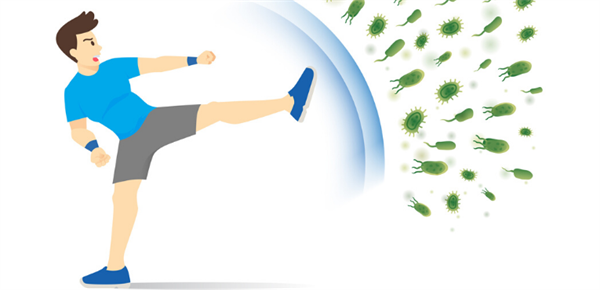Richard J. Simpson, Ph.D., FACSM |
March
30, 2020
 The human immune system is a highly intricate network of cells and molecules designed to keep the host free from infection and disease. Exercise is known to have a profound impact on the normal functioning of the immune system. Having higher age and sex-adjusted scores for cardiorespiratory fitness and performing regular exercise of moderate- to vigorous-intensity exercise that fall within ACSM guidelines has been shown to improve immune responses to vaccination, lower chronic low-grade inflammation, and improve various immune markers in several disease states including cancer, HIV, cardiovascular disease, diabetes, cognitive impairment and obesity. The ongoing COVID-19 pandemic has raised a lot of questions regarding how exercise can protect us from infection by boosting immunity. This is becoming more pertinent as many of us have restricted access to the gyms and parks where we would normally undertake exercise and physical activity regimens. Compounding this problem are the known negative effects of social isolation and confinement on immunity. Glucocorticoids such as cortisol are elevated during periods of isolation and confinement and can inhibit many critical functions of our immune system. When we are stressed, the ability of our T-cells to multiply in response to infectious agents is markedly reduced, as is the ability of certain effector lymphocytes (e.g., NK-cells and CD8+ T-cells) to recognize and kill cells in our body that have become cancerous or have been infected with viruses. It is also vitally important that our immune cells maintain their ability to redeploy so that they may ‘patrol’ vulnerable areas in or body (e.g., the upper respiratory tract and the lungs) to prevent viruses and other pathogens from gaining a foothold. This process is also important to minimize the impact of the virus and to expedite viral resolution should we become infected.
The human immune system is a highly intricate network of cells and molecules designed to keep the host free from infection and disease. Exercise is known to have a profound impact on the normal functioning of the immune system. Having higher age and sex-adjusted scores for cardiorespiratory fitness and performing regular exercise of moderate- to vigorous-intensity exercise that fall within ACSM guidelines has been shown to improve immune responses to vaccination, lower chronic low-grade inflammation, and improve various immune markers in several disease states including cancer, HIV, cardiovascular disease, diabetes, cognitive impairment and obesity. The ongoing COVID-19 pandemic has raised a lot of questions regarding how exercise can protect us from infection by boosting immunity. This is becoming more pertinent as many of us have restricted access to the gyms and parks where we would normally undertake exercise and physical activity regimens. Compounding this problem are the known negative effects of social isolation and confinement on immunity. Glucocorticoids such as cortisol are elevated during periods of isolation and confinement and can inhibit many critical functions of our immune system. When we are stressed, the ability of our T-cells to multiply in response to infectious agents is markedly reduced, as is the ability of certain effector lymphocytes (e.g., NK-cells and CD8+ T-cells) to recognize and kill cells in our body that have become cancerous or have been infected with viruses. It is also vitally important that our immune cells maintain their ability to redeploy so that they may ‘patrol’ vulnerable areas in or body (e.g., the upper respiratory tract and the lungs) to prevent viruses and other pathogens from gaining a foothold. This process is also important to minimize the impact of the virus and to expedite viral resolution should we become infected.
View COVID-19 Reopening and Return to Play Resources
Each bout of exercise, particularly whole-body dynamic cardiorespiratory exercise, instantaneously mobilizes literally billions of immune cells, especially those cell types that are capable of carrying out effector functions such as the recognition and killing of virus-infected cells. The mobilized cells firstly enter the blood compartment from marginated vascular pools, the spleen and the bone marrow before trafficking to secondary lymphoid organs and tissues, particular to the lungs and the gut where increased immune defense may be required. The immune cells that are mobilized with exercise are primed and ‘looking for a fight.’ Their frequent recirculation between the blood and tissues functions to increase host immune surveillance, which, in theory, makes us more resistant to infection and better equipped to deal with any infectious agent that has gained a foothold. Exercise also releases various proteins that can help maintain immunity, particularly muscle-derived cytokines such as IL-6, IL-7 and IL-15. The cytokine IL-6 has been shown to ‘direct’ immune cell trafficking toward areas of infection, while IL-7 can promote the production of new T-cells from the thymus and IL-15 helps to maintain the peripheral T-cell and NK-cell compartments, all of which work in concert to increase our resistance to infection. Exercise is especially beneficial for older adults who are more susceptible to infection in general and have also been identified as a particularly vulnerable population during this COVID-19 outbreak.
View COVID-19 Updates and Resources
In this regard, it is vitally important that we try to maintain our activity levels within recommended guidelines. Not only can exercise have a positive direct effect on the cells and molecules of the immune system, but it is also known to counter the negative effects of isolation and confinement stress on various aspects of immunity. Although no scientific data currently exists regarding the effects of exercise on coronaviruses, there is evidence that exercise can protect the host from many other viral infections including influenza, rhinovirus (another cause of the common cold) and herpesviruses such as Epstein-Barr (EBV), varicella-zoster (VZV) and herpes-simplex-virus-1 (HSV-1). Work from Jeff Woods’ lab at the University of Illinois showed that moderate-intensity exercise training during an active influenza infection protected mice from death. It also promoted a favorable immune cell composition and cytokine shift in the lungs that was associated with prolonged survival. A major focus of our research is to understand how exercise can mitigate the negative effects of stress to maintain immune function, particularly during prolonged periods of isolation and confinement such as space travel. We showed recently that astronauts who had higher pre-flight cardiorespiratory fitness and skeletal muscle endurance before a six-month mission to the International Space Station were less likely to reactivate EBV and VZV during the mission. Copies of EBV viral DNA were also lower in the fitter astronauts, indicating that their ability to infect others is also reduced. Moreover, those astronauts who had lower pre-flight fitness levels and returned to Earth with the greatest levels of cardiorespiratory deconditioning were more likely to have reactivated a virus during the mission. Viral reactivation is a global indicator that our immune system has been weakened, which, in this context, we believe to be largely due to the stressors associated with isolation and confinement. This research indicates that exercise, in addition to the aforementioned direct effects it can have on cells and molecules of the immune system, may be an effective stress-induced countermeasure to help maintain immune function and lower infection risk.
Currently, the greatest risk of COVID-19 infection is exposure. It is paramount that we find creative ways to exercise while maintaining social distancing and proper hygienic countermeasures. While exercise may not prevent us from becoming infected if exposed, it is likely that keeping active will boost our immune system to help minimize the deleterious effects of the virus, ameliorate our symptoms, expedite our recovery times and lower the likelihood that we can infect others with whom we come into contact. This is merely my intuition, but I do expect a large body of exercise immunology research to follow after this pandemic so that we can provide more specific exercise recommendations as they pertain to infection risk and control in both healthy and clinical populations.
Tips for Staying Active at Home
Lee este blog en español
 Richard J. Simpson, Ph.D., FACSM, is an associate professor in the Departments of Nutritional Sciences, Pediatrics and Immunobiology at the University of Arizona. His research interests are concerned with the effects of aging, stress and exercise on the immune system. Major focus areas include understanding: 1) how exercise and other behavioral interventions can offset age-related decrements in the normal functioning of the immune system (immunosenescence); 2) how adrenergic receptor signaling can be used to improve cellular products for hematopoietic stem cell transplantation and immunotherapy; 3) the interplay between the immune and neuroendocrine system during high level human performance and extreme isolation (i.e., space travel); and 4) how persistent virus infections such as cytomegalovirus (CMV) can alter the phenotype and function of T-cells and NK-cells to protect the host from certain hematological malignancies. Dr. Simpson is an ACSM Fellow and president-elect of the International Society of Exercise Immunology (ISEI). His research is supported by multiple NASA grants, the NIH (National Cancer Institute) and industry.
Richard J. Simpson, Ph.D., FACSM, is an associate professor in the Departments of Nutritional Sciences, Pediatrics and Immunobiology at the University of Arizona. His research interests are concerned with the effects of aging, stress and exercise on the immune system. Major focus areas include understanding: 1) how exercise and other behavioral interventions can offset age-related decrements in the normal functioning of the immune system (immunosenescence); 2) how adrenergic receptor signaling can be used to improve cellular products for hematopoietic stem cell transplantation and immunotherapy; 3) the interplay between the immune and neuroendocrine system during high level human performance and extreme isolation (i.e., space travel); and 4) how persistent virus infections such as cytomegalovirus (CMV) can alter the phenotype and function of T-cells and NK-cells to protect the host from certain hematological malignancies. Dr. Simpson is an ACSM Fellow and president-elect of the International Society of Exercise Immunology (ISEI). His research is supported by multiple NASA grants, the NIH (National Cancer Institute) and industry.